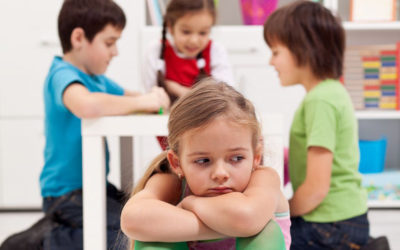It has been my experience over the past 20-years that many children with speech and language disorders often have poor self-confidence and weak social communication skills. Speech and language disorders can make it difficult for children to engage in the normal give-and-take of conversation. In a study completed by Jerome, Fujiki, Brinton and James, it was found that children with specific language impairments have a significantly lower perception of themselves than their typically developing peers by the age of 10 (2002). This difference in their self-esteem was especially evident in the areas of academic competence, social acceptance and behavioral skills. Here are 3 strategies I have found helpful in improving a child’s self-esteem and build stronger social skills.
1. Teach them about “non-verbal” communication.
We communicate messages ALL day without using any words at all! Did you know that 93% of all communication is non-verbal ? “Nonverbal communication” (or body language) includes facial expressions, body language, body contact, eye contact, personal space and even our tone of voice. I have found that kids with learning and attention issues often have difficulty understanding body language and picking up on social cues . One way to help understand nonverbal communication, is to show your child how different body movements have clear and concise meanings. Talk about how body language/nonverbal communication can have both positive and negative perceived meanings and demonstrate different forms of nonverbal communications and explain the unspoken message behind each movement. For example, “When someone is tapping their fingers like this (as you tap your fingers), it typically means they are losing patients”. Print the handout below and sort the examples of nonverbal communications and discuss the meanings with your child. Then, come up with more of your own!
Download: Types of Non-Verbal Communication
2. Be a good model and Role-Play Positive Social Skills with Your Child
As you probably already know, the first place your child learns about social skills is from watching you and your interactions with others. So modeling the positive social skills that you want your child to use are very important. This includes showing confidence in ourselves when we relate to others, being friendly to strangers, offering to help others, use good eye contact, and respecting personal space. I use role-playing to teach a variety of interaction skills, especially those involving initiating interactions, responding to greetings and questions, and terminating interactions. Pick a social goal that your child is working on and brainstorm ALL the places you will be going with your child over the week and how this goal could be addressed in each setting. Then roll-play with your child using this skill with different people (adults and peers) in the different environments.
3. Use Social Stories
I often use Social Stories to introduce a specific social skill or to address a skill that has been troublesome for a child to learn. You can use them to teach a number of social concepts, such as establishing eye contact, practicing turn taking skills, and introducing yourself. Social Stories present social concepts and rules to children in the form of a brief story that is printed. I find the fact that they are visual, tangible, and can be repeated that they work very well. I typically create personal Social Stories using pictures and symbols that are meaning for the child. I have found that many children learn best when Social Stories are used in conjunction WITH Role-Playing and used as a social primer. That means that after reading the Social Story, the child then practices the skill introduced in the story. For instance, immediately after reading a story about maintaining eye contact while talking to others, the child would practice the skill. Then, after reading the story and practicing the skill, the child would be exposed to a social situation where he would have an opportunity to perform the skill. Here is a link with many resources for creating your own social stories.

4. Set up Situations for Your Child to Practice Their Skills
our child now needs real-life opportunities to practice these skills they have read about and role-played. So, after reading the social stories and role-playing, it time to take your child to where they will have the opportunity to use their skills. Before turning them loose, review the targeted skill, discuss possible scenarios and ways your child could handle them one more time. Then let them go practice! After the social encounter (when you and your child are alone) discuss how it went. Did they achieve their goal? How did they feel? What could they improve on next time?
Teaching social skills can be very challenging but by using these strategies, you will begin to see positive changes! If you need additional help, and want to find out ways we can assist, call our office for a free consultation/screening.

